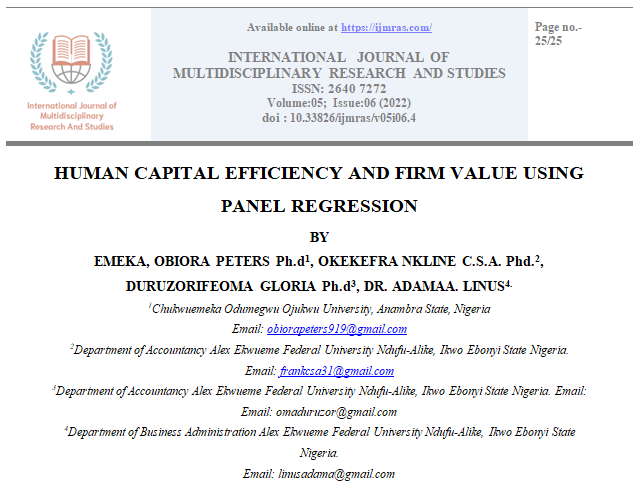HUMAN CAPITAL EFFICIENCY AND FIRM VALUE USING PANEL REGRESSION

Abstract
This study evaluated human capital efficiency and firm value of quoted Non-financial firms in Nigeria. Its core objective is to evaluate the effect human capital efficiency has on firm values. The study employed secondary data and panel regression models which were subjected to descriptive Statistics, Correlation Matrix, and Hausman test for interpretations. Data was collected from (76) quoted Non-financial firms from the year (2011-2020). The study was anchored in Resource-based theory. Findings hold that there is a negative influence of capital employed efficiency as it has positive but not significant influence, firm size (FISZ) has negative and significant influence and firm age (FIRA) has positive and non-significant influence on firm value of non-financial firms in Nigeria. Concluding, only human capital employed efficiency and firm age influenced firm value positively and thus the study recommends that the human capital component of intellectual capital should be trained and educated regularly to build capacity.
Firms’ specific growth and sustainability policy should be strongly placed using corporate governance code and other enhanced internal innovative processes to ensure that their existence is not affected by age.
Keywords
Human Capital, Efficiency, Structural Capital, Capital Employed, Firm ValueHow to Cite
References
Adegbayibi, A.T. (2021). Intellectual Capital and Firms’ Performance Measures of Listed Non-Financial Companies in Nigeria.
Ahesha, P. &Sujani, T. (2012). Impact of Human Capital Investment on Firm Financial Performances: An Empirical Study of Companies in Sri Lanka. DOI: 10.7763/IPEDR. 54. 3
Ali TalipAkpinar, et al. (2014). Intellectual Capital. Research paper. Kocaeli University Institute of Social Science, Turkey.
Azlina, R., Atan, R. &Kamaluddin, A. (2017). Human Capital Efficiency and Firm Performance: An Empirical Study on Malaysian Technology Industry. SHS Web of Conferences 36. DOI: 10.1051/s hsconf/20173600026
Barney, J. B. (1991). Firm Resources and Sustained Competitive Advantage. Journal of Management, 17, 99–120.
Bontis, N.(2001). Assessing knowledge assets: A review of the models used to measure intellectual capital. Int. Journal of Management Review, 3, 41–60.
Edvinsson, L.& Malone, S.M.(1997). Intellectual Capital: Realizing your Company’s True Value by Finding Its Hidden Brainpower; Harper Business: New York, NY, USA.
Githaiga, N.P.(2019). Understanding the Effect of Human Capital and Firm Performance in Kenya: A Panel Data Analysis. Nile Journal of Business and Economics,5(12)
Gunawan, H.&Ramadhani, W.(2018). How Intellectual Capital affects Firms Financial Performance. Journal of Applied Accounting and Taxation,3(1), 1-8
Hasan, S. & Hasan, H. A. (2019). Intellectual Capital and Financial Performance: Empirical Evidence from Iraq Stock Exchange (ISE), Academy of Accounting and Financial Studies Journal, 23(1)
Ismaila, Y. (2013). The Relationship between Human Capital Efficiency and Financial Performance: An Empirical Investigation of Quoted Nigerian Banks. Research Journal of Finance and Accounting, 4(4)
Kamath, G.B. (2015). Impact of Intellectual Capital on Financial Performance and Market Valuation of Firms in India. International Letters of Social and Humanistic Sciences, 48,107-122. doi:10.18052/www.scipress.com/ILSHS.48.107
Mehraliana, G.E., Hamid, R. R., Peyman, A. & Mohammad, R. S. (2012). The Impact of Intellectual Capital Efficiency on Market Value: An Empirical Study from Iranian Pharmaceutical Companies. Iranian Journal of Pharmaceutical Research, 11 (1): 195-207
Mohammad, H. S. (2021). The Interaction Effect of Human Capital Efficiency on the Nexus between Intellectual Capital and Profitability: Evidence from Malaysian SMEs. International Journal of Academic Research in Accounting Finance and Management Sciences, 11(1), 183-200
Nassar, S. (2018). The Impact of Intellectual Capital on Firm Performance of the Turkish Real Estate Companies before and after the Crisis. European Scientific Journal,14(1)
Nazari, J.A. &Herremans, I.M. (2007). Extended VAIC model: Measuring intellectual capital components. J. Intellect. Capital, 8, 595–609
Nguyen, A.H. & Doan, D.T.(2020). The Impact of Intellectual Capital on Firm Value: Empirical Evidence from Vietnam. International Journal of Financial Research,11(4)
Ovechkin, D.V., Romashkina, G.F.& Davydenko, V.A.(2021). The Impact of Intellectual Capital on the Profitability of Russian Agricultural Firms. Agronomy, 11, 286. https://doi.org/10.3390/agronomy11020286
Ozkan, N., Cakan, S. &Kayacan, M. (2017). Intellectual Capital and Financial Performance: A Study of the Turkish Banking Sector," Borsa Istanbul Review, Research, and Business Development Department, Borsa Istanbul. 17(3), 190-198,
Garima, S., Nemiraja, J. &Anto, J.(2021) The Relationship Between Human Capital and Firm Value: Evidence From Indian Firms. Cogent Economics & Finance, 9(1). DOI: 10.1080/23322039.2021.1954317
Parham S. & Heling G. (2015), The Relationship between Human Capital Efficiency and Financial Performance of Dutch Production Companies, Research Journal of Finance and Accounting; 6(8), 188-201.
Popoola, A., Edem, D.A.P. &Agbi, E.S. (2019).Structural Capital Efficiency and Financial Performance of Listed Oil and Gas Firms in Nigeria. Amity Journal of Management Research, 4 (2), 16-28
Pulic, A.(2000). VAIC—An Accounting Tool for IC Management. International Journal of Technology Management, 20, 702–714
Rezende, J. F. C., & Silva, M. P. (2021). Value Added by Intellectual Capital: A Study from the Brazilian B3 ́s ISE portfolio – Corporate Sustainability Index. Gestão& Produção, 28(2), e5124. https://doi.org/10.1590/1806-9649-2020v28e5124
Stewart, T. (1997). Intellectual Capital, the new Wealth of Organization, Doubleday, New York
Ting, W.K. & Lean H. H. (2009). Intellectual Capital Performance Of Financial Institutions In Malaysia. Journal of Intellectual Capital, 10(4), 588- 599.
Tseng, C. & Goo, J. (2005). Intellectual Capital and Corporate Value in an Emerging Economy: Empirical Study of Taiwanese Manufacturers”, R&D Management, 35(2),187-201.
Wang, W., &Chang, Ch. (2005).Intellectual Capital and Performance in Causal Models. Evidence from the Information Technology Industry in Taiwan, Journal of Intellectual Capital, 6(2), 222-236.
Wernerfelt, B. (1984). A Resource-Based View of the Firm. Strategic Management Journal, 5, 171–180
Yusuf I. (2013), The Relationship between Human Capital Efficiency and Financial Performance: An Empirical Examination of Quoted Nigerian Banks. Research Journal of Finance and Accounting; 4(4), 148-154.
License
Copyright (c) 2022 Dr. EMEKA, OBIORA PETERS., Dr. OKEKE, FRANKLINE C.S.A ., Dr. DURUZOR, IFEOMA GLORIA ., Dr. ADAMA. A. LINUS.

This work is licensed under a Creative Commons Attribution 4.0 International License.
Individual articles are published Open Access under the Creative Commons Licence: CC-BY 4.0.




